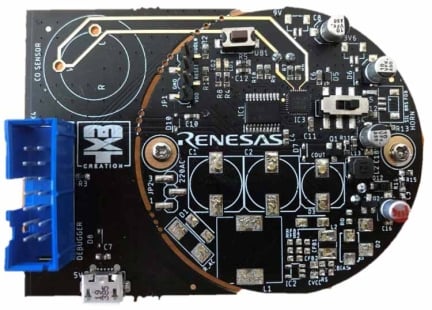Overview
Description
A photoelectric smoke detector consists of an IR photodiode (sender) and a phototransistor (receiver/detector) arranged inside a so-called smoke chamber. Inside this chamber, air is flowing, and this air may contain smoke from a nearby (upcoming) fire, etc.
The construction of the smoke chamber prevents (day) light from getting into the chamber to not disturb the measurements. As both transmitter and detector are positioned at an angle of ~120 to 150 degrees, the light is not directed at the sensor in clean or "low polluted" air. But if the air in the chamber contains particles (e.g., due to smoke or dust), the light is scattered and some of it reaches the detector, which results in triggering an audible alarm (piezo-horn, buzzer).
This smoke detector design using Renesas' RAA239101 low power analog front-end (AFE) IC with the RL78/G12 MCU includes peripherals and features for a photoelectric smoke detector system.
Features
- Device will detect smoke in 10-second intervals
- A red LED indicates the detection of smoke
- Device can be powered using a DC or AC source
Applications
Documentation
|
|
|
|
|---|---|---|
| Type | Title | Date |
| Manual - Hardware | PDF 2.03 MB | |
| Manual - Software | PDF 625 KB | |
| Quick Start Guide | PDF 700 KB | |
3 items
|
||
Design & Development
Software & Tools
Lab on the Cloud
Lab on the Cloud
This smoke detector solution using the RAA239101 low-power AFE IC with the RL78/G12 MCU includes peripherals and features for a photoelectric smoke detector system.
Videos & Training
Demonstration of Renesas’ Lab on the Cloud virtual environment for the Household Smoke Detector Solution.
